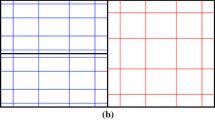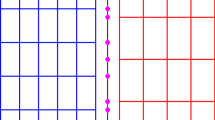Abstract
Non-conforming numerical approximations offer increased flexibility for applications that require high resolution in a localized area of the computational domain or near complex geometries. Two key properties for non-conforming methods to be applicable to real world applications are conservation and energy stability. The summation-by-parts (SBP) property, which certain finite-difference and discontinuous Galerkin methods have, finds success for the numerical approximation of hyperbolic conservation laws, because the proofs of energy stability and conservation can discretely mimic the continuous analysis of partial differential equations. In addition, SBP methods can be developed with high-order accuracy, which is useful for simulations that contain multiple spatial and temporal scales. However, existing non-conforming SBP schemes result in a reduction of the overall degree of the scheme, which leads to a reduction in the order of the solution error. This loss of degree is due to the particular interface coupling through a simultaneous-approximation-term (SAT). We present in this work a novel class of SBP–SAT operators that maintain conservation, energy stability, and have no loss of the degree of the scheme for non-conforming approximations. The new degree preserving discretizations require an ansatz that the norm matrix of the SBP operator is of a degree \(\ge 2p\), in contrast to, for example, existing finite difference SBP operators, where the norm matrix is \(2p-1\) accurate. We demonstrate the fundamental properties of the new scheme with rigorous mathematical analysis as well as numerical verification.












Similar content being viewed by others
Notes
Here we have not transferred the action of the derivative onto the test function; in the present context these two forms are algebraically equivalent as a result of constant grid metrics [19].
References
Carpenter, M.H., Fisher, T.C., Nielsen, E.J., Frankel, S.H.: Entropy stable spectral collocation schemes for the Navier–Stokes equations: discontinuous interfaces. SIAM J. Sci. Comput. 36, B835–B867 (2014)
Carpenter, M.H., Gottlieb, D.: Spectral methods on arbitrary grids. J. Comput. Phys. 129, 74–86 (1996)
Carpenter, M.H., Gottlieb, D., Abarbanel, S.: Time-stable boundary conditions for finite-difference schemes solving hyperbolic systems: methodology and application to high-order compact schemes. J. Comput. Phys. 111, 220–236 (1994)
Carpenter, M.H., Kennedy, C.A.: Fourth-order 2N-storage Runge–Kutta schemes. Tech. Report, NASA TM-109112. NASA Langley Research Center (1994)
Carpenter, M.H., Nordström, J., Gottlieb, D.: A stable and conservative interface treatment of arbitrary spatial accuracy. J. Comput. Phys. 148, 341–365 (1999)
Del Rey Fernández, D.C., Boom, P.D., Zingg, D.W.: A generalized framework for nodal first derivative summation-by-parts operators. J. Comput. Phys. 266, 214–239 (2014)
Del Rey Fernández, D.C., Hicken, J.E., Zingg, D.W.: Review of summation-by-parts operators with simultaneous approximation terms for the numerical solution of partial differential equations. Comput. Fluids 95, 171–196 (2014)
Del Rey Fernández, D.C., Hicken, J.E., Zingg, D.W.: Simultaneous approximation terms for multidimensional summation-by-parts operators. J. Sci. Comput. (see arXiv:1605.03214v2 [math.NA]), (2016)
Del Rey Fernández, D.C., Zingg, D.W.: Generalized summation-by-parts operators for the second derivative with a variable coefficient. SIAM J. Sci. Comput. 37, A2840–A2864 (2015)
Del Rey Fernández, D.C., Zingg, D.W.: Corner-corrected diagonal-norm summation-by-parts operators for the first derivative with increased order of accuracy. J. Comput. Phys. 330, 902–923 (2017)
Fisher, T.C., Carpenter, M.H.: High-order entropy stable finite difference schemes for nonlinear conservation laws: finite domains. J. Comput. Phys. 252, 518–557 (2013)
Gassner, G.J.: A skew-symmetric discontinuous Galerkin spectral element discretization and its relation to SBP–SAT finite difference methods. SIAM J. Sci. Comput. 35, A1233–A1253 (2013)
Gassner, G.J., Winters, A.R., Kopriva, D.A.: Split form nodal discontinuous Galerkin schemes with summation-by-parts property for the compressible Euler equations. J. Comput. Phys. 327, 39–66 (2016)
Gustafsson, B., Kreiss, H.-O., Oliger, J.: Time Dependent Problems and Difference Methods. In: Pure and Applied Mathematics, 2nd edn. Willey, New York (2013)
Hicken, J.E., Del Rey Fernández, D.C., Zingg, D.W.: Opportunities for efficient high-order methods based on the summation-by-parts property, In: 22nd Conference on AIAA Computational Fluid Dynamics, AIAA Paper 2015-3198, Dallas, Texas, USA, (2015)
Hicken, J.E., Del Rey Fernández, D.C., Zingg, D.W.: Multidimensional summation-by-part operators: general theory and application to simplex elements. SIAM J. Sci. Comput. 38, A1935–A1958 (2016)
Hicken, J.E., Del Rey Fernández, D.C., Zingg, D.W.: Simultaneous approximation terms for multidimensional summation-by-parts operators, In: 46th Conference on AIAA Fluid Dynamics, Washington, DC, USA. (Accepted) (2016)
Hicken, J.E., Zingg, D.W.: Summation-by-parts operators and high-order quadrature. J. Comput. Appl. Math. 237, 111–125 (2013)
Kopriva, D.A., Gassner, G.J.: On the quadrature and weak form choices in collocation type discontinuous Galerkin spectral element methods. J. Sci. Comput. 44, 136–155 (2010)
Kozdon, J.E., Wilcox, L.C.: Stable coupling of nonconforming, high-order finite difference methods. SIAM J. Sci. Comput. 3, A923–A952 (2016)
Lundquist, T., Nordström, J.: On the suboptimal accuracy of summation-by-parts schemes with non-conforming block interfaces. Tech. Report, LiTH-MAT-R-2015/16-SE. Linköping University (2015)
Mattsson, K.: Summation by parts operators for finite difference approximations of second-derivatives with variable coefficients. J. Sci. Comput. 51, 650–682 (2012)
Mattsson, K., Almquist, M., Carpenter, M.H.: Optimal diagonal-norm SBP operators. J. Comput. Phys. 264, 91–111 (2014)
Mattsson, K., Carpenter, M.H.: Stable and accurate interpolation operators for high-order multiblock finite difference methods. SIAM J. Sci. Comput. 32, 2298–2320 (2010)
Mattsson, K., Nordström, J.: Summation by parts operators for finite difference approximations of second derivatives. J. Comput. Phys. 199, 503–540 (2004)
Nordström, J., Carpenter, M.H.: Boundary and interface conditions for high-order finite-difference methods applied to the Euler and Navier-Stokes equations. J. Comput. Phys. 148, 621–645 (1999)
Nordström, J., Carpenter, M.H.: High-order finite-difference methods, multidimensional linear problems, and curvilinear coordinates. J. Comput. Phys. 173, 149–174 (2001)
Parsani, M., Carpenter, M.H., Nielsen, E.J.: Entropy stable wall boundary conditions for the three-dimensional compressible Navier-Stokes equations. J. Comput. Phys. 292, 88–113 (2015)
Svärd, M., Nordström, J.: Review of summation-by-parts schemes for initial-boundary-value-problems. J. Comput. Phys. 268, 17–38 (2014)
Acknowledgements
The work of Lucas Friedrich, Andrew Winters and Gregor Gassner was funded by the Deutsche Forschungsgemeinschaft (DFG) Grant TA 2160/1-1. The work of Jason Hicken was partially funded by the Air Force Office of Scientific Research Award FA9550-15-1-0242 under Dr. Jean-Luc Cambier. This work was partially performed on the Cologne High Efficiency Operating Platform for Sciences (CHEOPS) at the Regionales Rechenzentrum Köln (RRZK).
Author information
Authors and Affiliations
Corresponding author
Electronic supplementary material
Below is the link to the electronic supplementary material.
Appendices
A Projection Operators
In this section we briefly discuss the construction of the projection operators \(\mathsf {P}_{\xi ,L}\) and \(\mathsf {P}_{\xi ,R}\) of degree p, which are applied in Sect. 5.3. Here we consider tensor-product based projection operators. As for the tensor-product SBP operators, we derive the projection operators in one dimension, denoted by \(\mathsf {P}_{\xi ,L}^{(1\text {D})}\) and \(\mathsf {P}_{\xi ,R}^{(1\text {D})}\). We focus on a left element L and a right element R with nodal distributions \(\varvec{\eta }_L\) and \(\varvec{\eta }_R\). Let \(\varvec{\eta }_{{\varGamma }}\) denote the nodal distribution on the intermediate grid, then (2.16) and (2.18) give us
and
for \(k=0,\dots ,p\). We reiterate, that the choice of the nodes on the intermediate grid is nearly arbitrary, the only requirement is that a 2p-accurate quadrature rule exists. In the case of \(\varvec{\eta }_{{\varGamma }}=\varvec{\eta }_L\) or \(\varvec{\eta }_{{\varGamma }}=\varvec{\eta }_R\), we set the projection operators to be the identity matrix. If we consider the Gauss nodes on the intermediate grid as in Sect. 5.4, the projection matrices are fully determined in the sense that no free parameters remain. In general, (A.1) and (A.2) are insufficient to fully specify \(\mathsf {P}_{\xi ,L}^{(1\text {D})}\) and \(\mathsf {P}_{\xi ,R}^{(1\text {D})}\). We want the approximation of the surface integral to be as close as possible to the approximated surface integral for the conforming case, in a sense that \(\mathsf {H}_{\eta _{L}}^{(1\text {D})}\approx (\mathsf {P}_{\xi ,L}^{(1\text {D})})^{\text {T}}\mathsf {M}_{\hat{{\varGamma }}}\mathsf {P}_{\xi ,L}^{(1\text {D})}\) and \(\mathsf {H}_{\eta _{R}}^{(1\text {D})}\approx (\mathsf {P}_{\xi ,R}^{(1\text {D})})^{\text {T}}\mathsf {M}_{\hat{{\varGamma }}}\mathsf {P}_{\xi ,R}^{(1\text {D})}\). Therefore, we use any remaining degrees of freedom to ensure that the modulus of each eigenvalue of the matrices \(\mathsf {H}_{\eta _{L}}^{(1\text {D})}-(\mathsf {P}_{\xi ,L}^{(1\text {D})})^{\text {T}}\mathsf {M}_{\hat{{\varGamma }}}\mathsf {P}_{\xi ,L}^{(1\text {D})}\) and \(\mathsf {H}_{\eta _{R}}^{(1\text {D})}-(\mathsf {P}_{\xi ,R}^{(1\text {D})})^{\text {T}}\mathsf {M}_{\hat{{\varGamma }}}\mathsf {P}_{\xi ,R}^{(1\text {D})}\) is as close to zero as possible.
Similarly, we motivate this optimization by analyzing the numerical flux in the left element for the upwind SAT, i.e. for \(\sigma =1\). For conforming nodal distributions, this numerical flux in one dimension for the linear advection equation, with unit wave speed, reduces to
For \(\sigma =1\), the numerical flux of the non-conforming approximation (2.14) reduces to
Here, \(\varvec{f}^{*,(1\text {D})}_L=\varvec{f}^{*,(1\text {D})}_{L,conf}\), if \(\mathsf {H}_{\eta _{L}}^{(1\text {D})}=(\mathsf {P}_{\xi ,L}^{(1\text {D})})^{\text {T}}\mathsf {M}_{\hat{{\varGamma }}}\mathsf {P}_{\xi ,L}^{(1\text {D})}\).
Our approach to optimize the eigenvalues of \(\mathsf {H}_{\eta _{L}}^{(1\text {D})}-(\mathsf {P}_{\xi ,L}^{(1\text {D})})^{\text {T}}\mathsf {M}_{\hat{{\varGamma }}}\mathsf {P}_{\xi ,L}^{(1\text {D})}\) and \(\mathsf {H}_{\eta _{R}}^{(1\text {D})}-(\mathsf {P}_{\xi ,R}^{(1\text {D})})^{\text {T}}\mathsf {M}_{\hat{{\varGamma }}}\mathsf {P}_{\xi ,R}^{(1\text {D})}\) is based on the work of Kozdon and Wilcox [20]. Here, a Levenberg–Marquardt optimization algorithm has been used. We set the number of optimization iterations within the algorithm to 10. For constructing one-dimensional projection operators a MATLAB code is provided in the electronic supplementary material (ESM).
B Comparison to the Non-conforming Method of Kozdon and Wilcox
To put the derivations using the multi-dimensional notation into context, it is useful to observe that for the tensor-product ansatz our approach is equivalent to the scheme of Kozdon and Wilcox [20]. In their notation, a projection from the left element to the glue grid is denoted by the one-dimensional projection operator \(\mathsf {P}_{L2G}\). The back transformation is denoted by \(\mathsf {P}_{G2L}\). If we also consider a tensor-product approximation and take the glue grid to be equivalent to our intermediate grid, then
Due to the accuracy conditions made for \(\mathsf {P}_{\xi ,L}^{(1\text {D})}\), the operator \(\mathsf {P}_{L2G}\) is also p-th degree.
For the approach of Kozdon and Wilcox, as for the approach of Mattsson and Carpenter [24], the projection operators need to satisfy the following condition to ensure stability:
Motivated by the stability condition one can construct a transformation back to left element
Multiplying (B.3) by a monomial, say \(\varvec{\eta }_{{\varGamma }}^{k}\) with \(k=0,\dots ,p\), and using (2.18) we find
So the \(\mathsf {P}_{G2L}\) is also p-th accurate. Considering the symmetric SAT in the discretization (2.12 with \(\sigma =0\)) and focusing on tensor-product operators, we get
Denoting \(\varvec{u}_{L,N}:= \mathsf {R}_{\xi _L,N_{\xi }}\varvec{u}_{L}\) and \(\varvec{u}_{R,1}:= \mathsf {R}_{\xi _{R},1}\varvec{u}_{R}\) we can rewrite (B.5) to become
which is precisely the SAT for the Kozdon and Wilcox approach, assuming a symmetric SAT, despite the fact we have a different approach to derive the SAT.
Rights and permissions
About this article
Cite this article
Friedrich, L., Del Rey Fernández, D.C., Winters, A.R. et al. Conservative and Stable Degree Preserving SBP Operators for Non-conforming Meshes. J Sci Comput 75, 657–686 (2018). https://doi.org/10.1007/s10915-017-0563-z
Received:
Revised:
Accepted:
Published:
Issue Date:
DOI: https://doi.org/10.1007/s10915-017-0563-z




